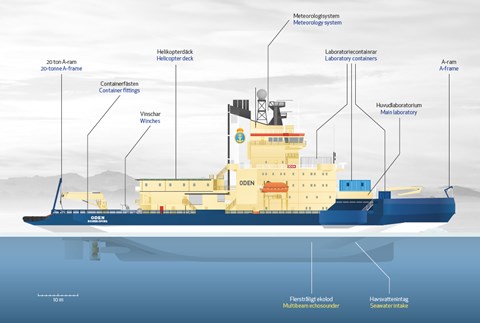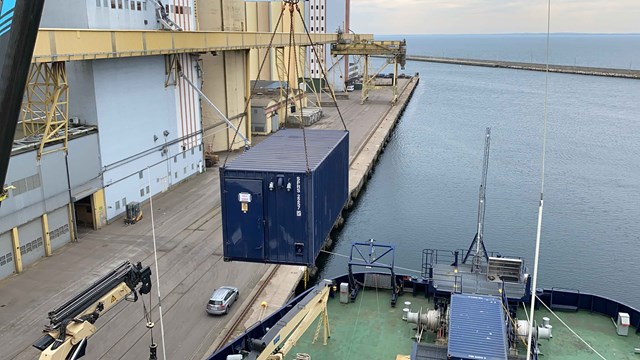Icebreaker Oden
The icebreaker Oden is one of the world's most powerful non-nuclear-powered icebreakers and one of the foremost platforms for research in the polar oceans.
Oden was constructed at the Arendal shipyard in Gothenburg and was launched in 1989. The vessel was intended for icebreaking operations in the Bay of Bothnia during the winter and for oil and gas extraction in the Arctic during the summer. When the latter mission was not realised, the Swedish Polar Research Secretariat began to charter the icebreaker for polar expeditions.
Since 1991, in collaboration with the Swedish Maritime Administration, the Swedish Polar Research Secretariat has regularly conducted research expeditions with Oden in the polar regions. On September 7, 1991, the icebreaker reached the North Pole, becoming the first non-nuclear-powered ship to do so. In August 2021, Oden visited the North Pole for the tenth time. Over five seasons, the icebreaker has also operated in Antarctica as part of a Swedish-American research collaboration.
The ship has been a highly successful platform in marine geology, oceanography, ecological research, and atmospheric research in the Arctic and Antarctica.
Research platform Oden
Over the years, Oden has been continuously equipped to meet research needs. Onboard installations have been funded through the Secretariat's resources and external funding, including support from the Knut and Alice Wallenberg Foundation, the Swedish Research Council, Swedish universities, and international collaborations. These investments include upgraded instruments for seafloor mapping, winches with fibre-optic cables for sampling at depths of thousands of meters, and improved systems for satellite communication and meteorological forecasting.
The ship's great flexibility with research containers, laboratories, and winches allows researchers from various disciplines to utilise the vessel. Before each expedition, Oden is also customised to accommodate expedition-specific equipment. In addition to the laboratory house on the foredeck, several research containers can be adjusted according to researchers' needs. These containers are furnished and equipped with water, sewage, compressed air, and electricity connections. Among the fixed equipment on Oden are trawl winches, air purification systems, cooling and freezing facilities (including -80°C), gas pipelines, and seawater intake. A multibeam echosounder enables 3D mapping of the seafloor.
Meteorological, oceanographic, and ship data are continuously collected during research expeditions. These data are available to researchers during and after the expedition, as they are published in public databases. (https://www.polar.se/stoed-till-polarforskning/oeppna-data/data-fraan-isbrytaren-oden/)
Oden is owned by the Swedish Maritime Administration. The Swedish Polar Research Secretariat represents the icebreaker in scientific activities in national and international contexts.

Efficient icebreaking
Thanks to the special design, Oden is extraordinarily manoeuvrable in heavy ice with its square bow, specific hull shape, ice knife, propellers with nozzles and oversized rudders. Thrusters at the bow spray jets of water to reduce the vessel's friction on the ice, and an anti-heeling system for wiggling the vessel side-to-side further enhances the ability to navigate the ice.
The main machinery consists of four engines in a diesel-mechanical system that delivers an output of 24,500 hp. The two propellers with nozzles measure 4.5 metres in diameter and are designed to cope with the ice load of polar oceans.
Tentative timetable for IB Oden 2021 - 2024
| Year | Expedition | Geographical area | Partners | Acronym |
|---|---|---|---|---|
| 2025 | Canada-Sweden Arctic Ocean 2025 | Arctic Ocean | Canada | |
| 2026 | Canada-Sweden Arctic Ocean 2025 | Arctic Ocean | Canada | |
| 2027 | Canada-Sweden Arctic Ocean 2025 | Arctic Ocean | Canada |



